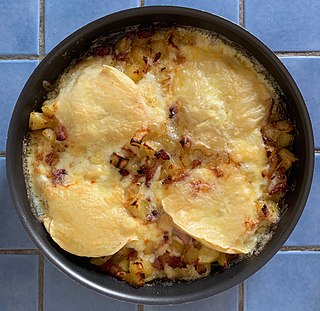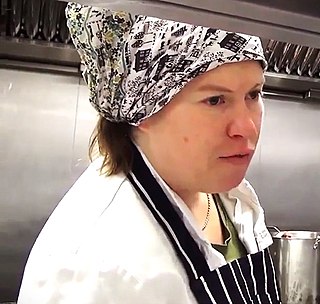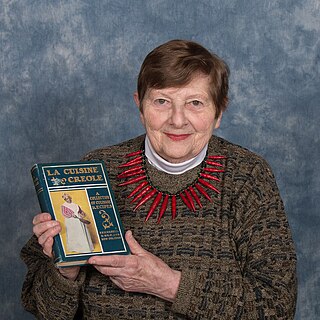
French cuisine is the cooking traditions and practices from France. In the 14th century, Guillaume Tirel, a court chef known as "Taillevent", wrote Le Viandier, one of the earliest recipe collections of medieval France. In the 17th century, chefs François Pierre La Varenne and Marie-Antoine Carême spearheaded movements that shifted French cooking away from its foreign influences and developed France's own indigenous style.

In cooking, a sauce is a liquid, cream, or semi-solid food, served on or used in preparing other foods. Most sauces are not normally consumed by themselves; they add flavor, moisture, and visual appeal to a dish. Sauce is a French word taken from the Latin salsa, meaning salted. Possibly the oldest recorded European sauce is garum, the fish sauce used by the Ancient Romans, while doubanjiang, the Chinese soy bean paste is mentioned in Rites of Zhou in the 3rd century BC.

A cookbook or cookery book is a kitchen reference containing recipes.

A mirepoix is a mixture of diced vegetables cooked with fat for a long time on low heat without coloring or browning. The ingredients are not sautéed or otherwise hard-cooked, because the intention is to sweeten rather than caramelize them. Mirepoix is a long-standing part of French cuisine and is the flavor base for a wide variety of dishes, including stocks, soups, stews, and sauces.

Marie-Antoine Carême, known as Antonin Carême, was a leading French chef of the early 19th century.

Haute cuisine or grande cuisine is a style of cooking characterised by meticulous preparation, elaborate presentation, and the use of high quality ingredients. Typically prepared by highly skilled gourmet chefs, haute cuisine dishes are renowned for their high quality and are often offered at premium prices.

Georges Auguste Escoffier was a French chef, restaurateur, and culinary writer who popularized and updated traditional French cooking methods. Much of Escoffier's technique was based on that of Marie-Antoine Carême, one of the codifiers of French haute cuisine; Escoffier's achievement was to simplify and modernize Carême's elaborate and ornate style. In particular, he codified the recipes for the five mother sauces. Referred to by the French press as roi des cuisiniers et cuisinier des rois, Escoffier was a preeminent figure in London and Paris during the 1890s and the early part of the 20th century.

Tartiflette is a dish from Savoy in the French Alps and from Aosta Valley. It is made with potatoes, reblochon cheese, lardons and onions. A splash of white wine can be added too.

Gastronomy is the study of the relationship between food and culture, the art of preparing and serving rich or delicate and appetizing food, the cooking styles of particular regions, and the science of good eating. One who is well versed in gastronomy is called a gastronome, while a gastronomist is one who unites theory and practice in the study of gastronomy. Practical gastronomy is associated with the practice and study of the preparation, production, and service of the various foods and beverages, from countries around the world. Theoretical gastronomy supports practical gastronomy. It is related with a system and process approach, focused on recipes, techniques and cookery books. Food gastronomy is connected with food and beverages and their genesis. Technical gastronomy underpins practical gastronomy, introducing a rigorous approach to evaluation of gastronomic topics.

Choux pastry, or pâte à choux, is a delicate pastry dough used in many pastries. The essential ingredients are butter, water, flour and eggs.

Molecular gastronomy is the scientific approach of cuisine from primarily the perspective of chemistry. The composition, properties and transformations of an ingredient are addressed and utilized in the preparation and appreciation of the ingested products. It is a branch of food science that approaches the preparation and enjoyment of nutrition from the perspective of a scientist at the scale of atoms, molecules, and mixtures.
Anne Willan is the founder of the École de Cuisine La Varenne, which operated in Paris and Burgundy France, from 1975 until 2007. La Varenne classes continued in Santa Monica, California, through 2017.

The cuisine of early modern Europe was a mix of dishes inherited from medieval cuisine combined with innovations that would persist in the modern era.

Allegra Sarah Bazzett McEvedy MBE is an English chef, broadcaster and writer.

François Massialot was a French chef who served as chef de cuisine to various illustrious personages, including Philippe I, Duke of Orléans, the brother of Louis XIV, and his son Philippe II, Duke of Orléans, who was first duc de Chartres then the Regent, as well as the duc d'Aumont, the Cardinal d’Estrées, and the marquis de Louvois. His Le cuisinier roïal et bourgeois first appeared, anonymously, as a single volume in 1691, and was expanded to two (1712) then three volumes, in the revised edition of 1733–34. His lesser cookbook, Nouvelle instruction pour les confitures, les liqueurs et les fruits,, appeared, also anonymously, in 1692.

Lancelot de Casteau or de Chasteau or de Chestea, also known as Anseau de Chestea was the master chef for three prince-bishops of Liège in the 16th century: Robert de Berghes, Gérard de Groesbeek, and Ernest of Bavaria and the author of a cookbook, the Ouverture de cuisine, often considered the first cookbook to go beyond medieval recipes and to codify haute cuisine.

Janice Longone was an American food historian, Curator of American Culinary History at Special Collections, Hatcher Library, University of Michigan. Julia Child, James Beard, and New York Times food editor Craig Claiborne were all early fans of Longone's out-of-print cookbook collection. Their enthusiasm prompted her to create The Wine and Food Library in 1972, which offers books by mail order or private appointment and remains one of the most important antiquarian culinary resources in the world.

Darra Goldstein is an American author and food scholar who is the Willcox B. and Harriet M. Adsit Professor of Russian, emerita at Williams College.

Florentine or à la Florentine is a term from classic French cuisine that refers to dishes that typically include a base of cooked spinach, a protein component and Mornay sauce. Chicken Florentine is the most popular version. Because Mornay sauce is a derivation of béchamel sauce which includes roux and requires time and skill to prepare correctly, many contemporary recipes use simpler cream-based sauces.

The Virginia House-Wife is an 1824 housekeeping manual and cookbook by Mary Randolph. In addition to recipes it gave instructions for making soap, starch, blacking and cologne.


















